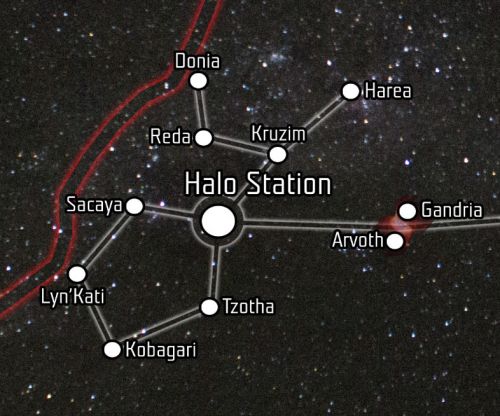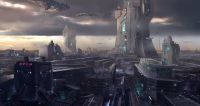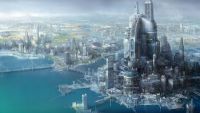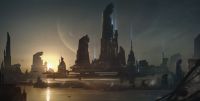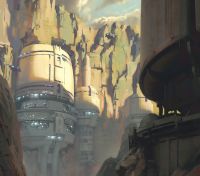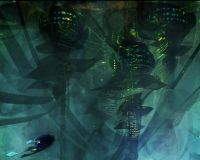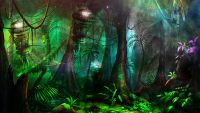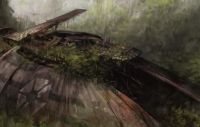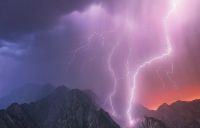Difference between revisions of "Halo Frontier"
| Line 2: | Line 2: | ||
[[Image:Halo-frontier.jpg|right|500px]] | [[Image:Halo-frontier.jpg|right|500px]] | ||
Named for the centrally-located space station Halo Station, the Frontier is a small cluster of worlds who share the dubious honor of being among the closest of worlds to the Void of Chopani, just across the sector border in the Chopani Sector. The Frontier worlds maintain a civil alliance, with a council of representatives who are explicitly denied any kind of say on an individual world's operation – here, "civility" means minding your own business. | Named for the centrally-located space station Halo Station, the Frontier is a small cluster of worlds who share the dubious honor of being among the closest of worlds to the Void of Chopani, just across the sector border in the Chopani Sector. The Frontier worlds maintain a civil alliance, with a council of representatives who are explicitly denied any kind of say on an individual world's operation – here, "civility" means minding your own business. | ||
| − | ==Halo Station== | + | ==[[Halo Station]]== |
The station was built after a series of wars among these worlds hundreds of years ago, a symbol of an alliance between those worlds. Now the station is a combination of government nexus, major trading hub, and haven for all sorts of unsavory sorts. It is also the preferred jumping off point for one of any number of explorers seeking to stake claims to new worlds they are sure exist within the Void. The discovery of the Antmuel system in the Void a generation ago sparked interest, but the discovery of Parvassis just three years ago has sparked something of a "gold rush" surge of effort – which is good for the station's economy. | The station was built after a series of wars among these worlds hundreds of years ago, a symbol of an alliance between those worlds. Now the station is a combination of government nexus, major trading hub, and haven for all sorts of unsavory sorts. It is also the preferred jumping off point for one of any number of explorers seeking to stake claims to new worlds they are sure exist within the Void. The discovery of the Antmuel system in the Void a generation ago sparked interest, but the discovery of Parvassis just three years ago has sparked something of a "gold rush" surge of effort – which is good for the station's economy. | ||
Revision as of 18:05, 28 November 2020
Named for the centrally-located space station Halo Station, the Frontier is a small cluster of worlds who share the dubious honor of being among the closest of worlds to the Void of Chopani, just across the sector border in the Chopani Sector. The Frontier worlds maintain a civil alliance, with a council of representatives who are explicitly denied any kind of say on an individual world's operation – here, "civility" means minding your own business.
Halo Station
The station was built after a series of wars among these worlds hundreds of years ago, a symbol of an alliance between those worlds. Now the station is a combination of government nexus, major trading hub, and haven for all sorts of unsavory sorts. It is also the preferred jumping off point for one of any number of explorers seeking to stake claims to new worlds they are sure exist within the Void. The discovery of the Antmuel system in the Void a generation ago sparked interest, but the discovery of Parvassis just three years ago has sparked something of a "gold rush" surge of effort – which is good for the station's economy.
Settled Worlds
Only a few of the worlds in the Halo Frontier can boast any kind of long-standing civilization. Even fewer have been around long enough to develop internal cultures and distinct societies, though there are a few.
Gandria
| Gandria Nebula • Terrestrial • Subarctic Climate • Tundra Terrain In the Gandria Nebula, around the gas giant Koba spins Gandria, a subarctic tundra-world that houses the oldest-known colony in the Halo Frontier. Gandria started off as a mission-colony of the Sokrinti Hegemony, but they have since split off into their own sect, the Sokrinti Disorthodoxy. |
Kobagari
| Kobagari System • Terrestrial • Multiclimate • Diverse Terrain The resources-rich, biome-diverse world of Kobagari was settled several generations ago by settlers from a core worlds monarchy overthrown in revolution by their own population. Fleeing their imminent deaths, the nobility and their supporters fled their homeworld and eventually settled here. Today, the human Kobagari Nobility are among the richest and most influential powers in the Halo Frontier, and Kobagari's population is measured in the hundreds of millions, with multiple nations each ruled by their own house of nobility. |
Lekanton
| Harea System • Terrestrial • Arid Climate • Desert + Barrens Terrain The sole moon orbiting the gas giant Harea IV, Lekanton is home to the chevin/rodian Lekanton Sovereignty, a dictatorship ruled by the chevin. Two-thirds of its rodian population as slave labor for the various ore mining stations in the astroids around Harea III and the gas mining projects in Harea IV's chemical atmosphere. |
Frontier Worlds
Frontier worlds are sparsely settled, although they do have at least one settlement if not more. The tech levels on such worlds tend to be import-based: that is, whatever those colonists can get their hands on. On worlds where the settlements are sponsored by someone (a government or corporation, usually), they may have somewhat better access to goods, but many settlements that are simply collections of folk looking to make better lives for themselves tend to make do as best they can.
Donia
| Donia System • Terrestrial • Arid Climate • Plains + Canyons Terrain Right on the edge of the Void of Chopani, Donia is a frontier world. The hot canyons and verdant plains of the world house a great many native herd animals, most of which have been domesticated. It houses only a few small outback settlements, none of them advanced enough to be called cities. Between these towns lie kilometers-wide ranch lands. Donia is also known for the vicious apex predators that hunt the herds, and which sometimes manage to wipe out ranches entirely, herd and folk alike. Donia is also known for the Bausec Monastery, a secluded contemplative community of Gand Findsmen who sometimes agree to accompany explorers bound for the Void of Chopani. |
Lyn'Kati
| Kati System • Terrestrial • Tropical Climate • Oceans Terrain The primarily-water world of Lyn'Kati is a deep blue-green sphere, with a great deal of volcanic activity around its equatorial belt, resulting in a chain of tropical islands that separate north and south equators. Though there are a few small settlements on some of the larger islands, Lyn'Kati is mainly known for the subaquatic settlement called Deepsong, a large colony of nautolans and karkaradons built into a deep-water trench. The colony maintains a trading outpost on a nearby island, called Deepsong Outpost, which is the closest thing Lyn'Kati has to a spaceport. |
Sacaya
| Sacaya System • Terrestrial • Diverse Climate • Mountainous Terrain An ore-rich world claimed by the Tiliq Mining Consortium. Though the Consortium has several facilities on the planet, they also sell commissions for others to set up operations there as well, charging high prices for the possibility of making a great deal of money. Tiliq is home to several barebones mining commune-colonies, groups of people who all pitch in to purchase the commission and work the mines, ideally splitting the profits (when there are any). |
Wilderness Worlds
Wilderness worlds are just that: untamed and wild. They may have bases, outposts or stations of some kind, but by and large they are unsettled. Wilderness worlds are favorite hide-outs for criminal groups.
Arvoth
| Gandria Nebula • Gas Giant Arvoth is best known for its Perimeter, a massive field of mineral-rich asteroids of interest to both mining concerns (notably the Tiliq Consortium) and pirates, and its ringed moon Dono where pirates often hide from pursuit or lay low between strikes. |
Harea II
| Harea System • Terrestrial • Temperate to Tropical Climate • Jungle + Swamp Terrain A large terrestrial jungle and swamp moon whose atmosphere requires an environment suit, thanks to the sheer proliferation of native toxins and diseases in it. The home of the Harean Rangers, a mercenary unit of scouts and guerilla-style fighters who specialize in fighting in dangerous environs. |
Kruzim
| Kruzim System • Terrestrial • Diverse Climate • Forest to Jungle Terrain Kruzim's surface is covered by immense plantlife. Its polar forests feature massive trees whose root systems grow together to form subterranean caverns, heated by the trees' internal processes, its temperate woodlands feature massive sky-scraper-sized trees, and its vast tropical jungles are notable for the fact that the incredible twisting, spiralling trees all appear to be a single composite organism, joined across the surface of the world by its root system. Kruzim's only sign of civilization are the deep scars caused by the crash of capital ships a couple of decades ago, from when it was the site of a Clone Wars engagement between Separatist and Republic capital ships in its upper atmosphere, several of which crashed here. |
Reda
| Reda System • Terrestrial • Arctic to Temperate Climate • Mountainous Terrain Reda's distinctive mountains rise up out of their cloudy valleys like knife-points, sharp and jagged. The fog that enshrouds the valleys are not simple mists, but in fact clouds – as the occasional lightning storms that rage just beneath the mountain peaks attest to. The ferrous ore in the mountains paired with the frequent lightning events makes Reda a dangerous place, although clearly someone once managed it, as some of the valleys feature extensive ruins of a sort that suggest an advanced (but pre-space flight) civilization long ago extinct. |
Tzotha
| Tzo System • Terrestrial • Temperate to Tropical Climate • Swamp Terrain A relatively small world with a moisture-rich atmosphere, Tzotha's surface is inundated by water that has never formed significant waterways, leading to a general waterlogging of the terrain. Twice-a-day rain showers ensure everything stays very wet, and the heat becomes positively choking. Which of course makes it the perfect hide-out for pirates and other criminal sorts to go to ground at. |
The Gandria Nebula
| Nebula A brilliant red-orange display of light, the Gandria Nebula is considered to be the outer edges of the Frontier, standing as it does between the Frontier and the rest of the Kanz Sector. It contains two proto-sun gas giants: Koba (around which Gandria orbits) and Arvoth. |
